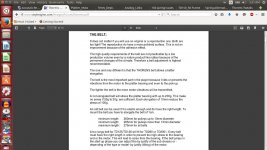If the old belt is present, which is to replace, this question does not arise. Otherwise this question arises.
The same situation occurs for a diy belt drive turntable resp. record player.
The steps for determine of belt length resp. circumference while operation are easy to perform:
1) the motor pulley and platter hub circumference at whole (without the belt installed) by tying a piece of thread around the belt’s path.
2) pinch (marking) of both ends of the thread and measuring its length.
But this is the length in stretched condition with a certain value of pretensioning force.
This value nobody don't know by no belt drive turntable model - so I guess.
The following question occurs at first glance:
How is to determine the correct belt circumference when it is not tensioned?
Nobody can answer the question exactly and it only comes up when the original belt is no longer available or haven't ever exist before.
For each belt drive record player/turntable there must actually exist only one ideal value for the pretensioning force resp. necessary degree of stretching. The degree of stretching itself is dependent of the compliance (large difference between rubber and polyurethane), additional probably from the kind of belt (e. g. flat or round) so as the belt size (thickness resp. diameter) and the surface finish.
So the real question is for finding the correct belt size as follow:
What is the correct value for the pretensioning force of belt (right contact pressure on motor pulley and platter)?
This value is dependent from the kind of drive motor so as from the wight of platter and the kind of bearing/spindle set-up.
Is this value to low, the unwanted effects (through elastic slippage) are clearly audible (due to the elasticity of the belt, elongation processes occur in the belt during rotation around the pulleys. These stretching processes are due to the increase (or decrease) in the belt tension at the transition from the slack side to the tight side (or vice versa) – the belt stretches according to the force acting on the pulley).
Is the value to high, this leads both to high bearing loads and to increases belt wear.
How do professional manufacturers (Linn REGA, Pro-Ject etc) determine this value ?
And how can the user this value determine correctly ?
Thank you for an advice.
some URLs (belt drive basics):
https://www.basisaudio.com/revolution-belt
https://www.brinkmann-audio.de/inhalt/en/technical/a_short_study_on_turntable_drives.pdf
https://www.diyaudio.com/community/threads/non-stretchable-t-t-drive-belt.385162/
https://www.tec-science.com/mechanical-power-transmission/belt-drive/maximum-belt-stress/
https://www.tec-science.com/mechani...elt-drive/power-transmission-of-a-belt-drive/
https://www.tec-science.com/mechanical-power-transmission/belt-drive/bearing-force/
P.S.:
where is this thread ?
https://www.diyaudio.com/community/threads/belt-drive-turntables-a-lesson-in-physics.358391
after try to open I get only this error message from diyaudio.com:
Oops! We ran into some problems. The requested thread could not be found.
The same situation occurs for a diy belt drive turntable resp. record player.
The steps for determine of belt length resp. circumference while operation are easy to perform:
1) the motor pulley and platter hub circumference at whole (without the belt installed) by tying a piece of thread around the belt’s path.
2) pinch (marking) of both ends of the thread and measuring its length.
But this is the length in stretched condition with a certain value of pretensioning force.
This value nobody don't know by no belt drive turntable model - so I guess.
The following question occurs at first glance:
How is to determine the correct belt circumference when it is not tensioned?
Nobody can answer the question exactly and it only comes up when the original belt is no longer available or haven't ever exist before.
For each belt drive record player/turntable there must actually exist only one ideal value for the pretensioning force resp. necessary degree of stretching. The degree of stretching itself is dependent of the compliance (large difference between rubber and polyurethane), additional probably from the kind of belt (e. g. flat or round) so as the belt size (thickness resp. diameter) and the surface finish.
So the real question is for finding the correct belt size as follow:
What is the correct value for the pretensioning force of belt (right contact pressure on motor pulley and platter)?
This value is dependent from the kind of drive motor so as from the wight of platter and the kind of bearing/spindle set-up.
Is this value to low, the unwanted effects (through elastic slippage) are clearly audible (due to the elasticity of the belt, elongation processes occur in the belt during rotation around the pulleys. These stretching processes are due to the increase (or decrease) in the belt tension at the transition from the slack side to the tight side (or vice versa) – the belt stretches according to the force acting on the pulley).
Is the value to high, this leads both to high bearing loads and to increases belt wear.
How do professional manufacturers (Linn REGA, Pro-Ject etc) determine this value ?
And how can the user this value determine correctly ?
Thank you for an advice.
some URLs (belt drive basics):
https://www.basisaudio.com/revolution-belt
https://www.brinkmann-audio.de/inhalt/en/technical/a_short_study_on_turntable_drives.pdf
https://www.diyaudio.com/community/threads/non-stretchable-t-t-drive-belt.385162/
https://www.tec-science.com/mechanical-power-transmission/belt-drive/maximum-belt-stress/
https://www.tec-science.com/mechani...elt-drive/power-transmission-of-a-belt-drive/
https://www.tec-science.com/mechanical-power-transmission/belt-drive/bearing-force/
P.S.:
where is this thread ?
https://www.diyaudio.com/community/threads/belt-drive-turntables-a-lesson-in-physics.358391
after try to open I get only this error message from diyaudio.com:
Oops! We ran into some problems. The requested thread could not be found.
Last edited:
Here some URLs:
https://allforturntables.com/2021/07/09/how-tight-should-turntable-belt-be/
https://vacationvinyl.com/this-is-how-tight-a-turntable-belt-should-be/
https://www.vinylengine.com/turntable_forum/viewtopic.php?t=77864
https://www.vinylengine.com/turntable_forum/viewtopic.php?t=77864
https://www.vinylengine.com/turntable_forum/viewtopic.php?t=27548
https://www.vinylengine.com/turntable_forum/viewtopic.php?t=19517
https://audiokarma.org/forums/index.php?threads/tight-belt-question.175028/
https://www.turntableneedles.com/how_to_measure_find_right_turntable_tape_player_rubber_drive_belt
https://audiokarma.org/forums/index.php?threads/belt-tightening.360548/
https://web.archive.org/web/20160222064431/http://www.rmcet.com/lib/Resources/E-Books/Mech-auto/E-Books Machine Design-Khurmi R.s/CHP-18.pdf
https://theanalogdept.com/replacing_the_belt.htm
https://allforturntables.com/2021/07/09/how-tight-should-turntable-belt-be/
https://vacationvinyl.com/this-is-how-tight-a-turntable-belt-should-be/
https://www.vinylengine.com/turntable_forum/viewtopic.php?t=77864
https://www.vinylengine.com/turntable_forum/viewtopic.php?t=77864
https://www.vinylengine.com/turntable_forum/viewtopic.php?t=27548
https://www.vinylengine.com/turntable_forum/viewtopic.php?t=19517
https://www.turntableneedles.com/how_to_measure_find_right_turntable_tape_player_rubber_drive_belt
https://audiokarma.org/forums/index.php?threads/belt-tightening.360548/
https://web.archive.org/web/20160222064431/http://www.rmcet.com/lib/Resources/E-Books/Mech-auto/E-Books Machine Design-Khurmi R.s/CHP-18.pdf
https://theanalogdept.com/replacing_the_belt.htm
Attachments
Last edited:
